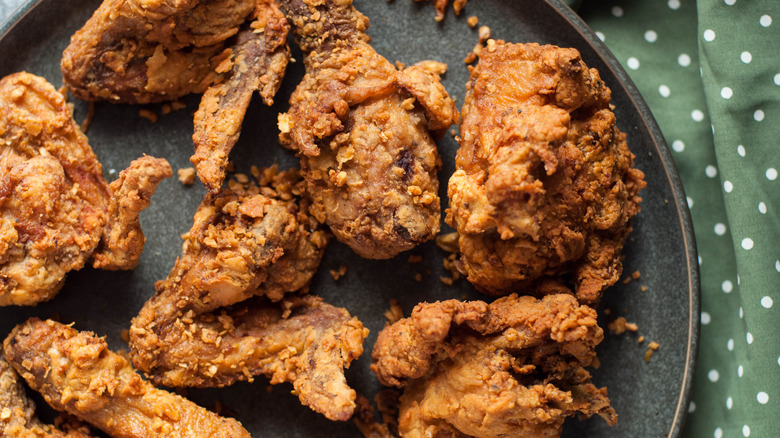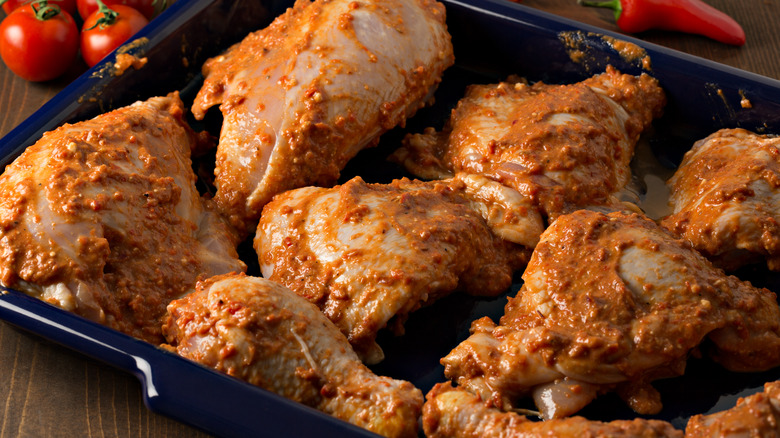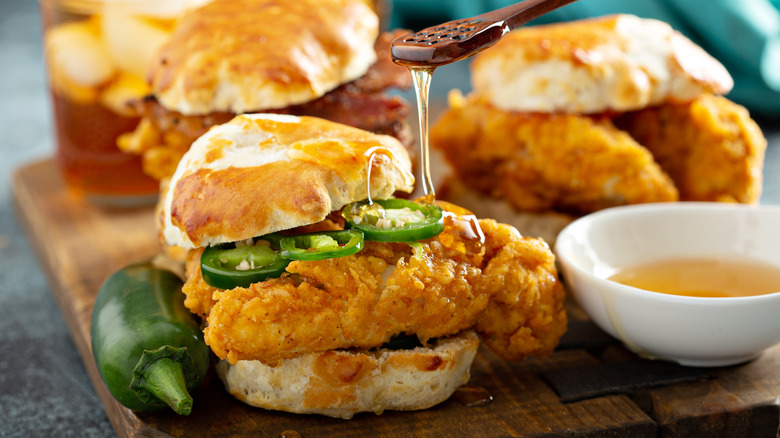The Important Addition You're Missing In Your Fried Chicken Marinade
With a crispy, crumbly exterior that gives way to succulent, juicy cuts of protein-packed poultry, fried chicken has stood the test of time for good reason. Delicious as it may be, however, making fried chicken isn't always a walk in the park. Sure, you can dredge a plain tender in egg, flour, and bread crumbs and mindlessly dunk it into the deep fryer, but that's just downright boring. A well-made batch of fried chicken requires effort and attention, and one way to give your fried chicken platter a bold, flavor-forward bravado is by marinating it before frying it. But don't just stick to the basics, upgrade your fried chicken marinade with hot sauce.
A barebones meat marinade is fashioned with acid, fat, and seasonings. Although this ensures a juicy cut of chicken threaded with flavor, a hot sauce-tinted marinade provides it with a bright, spicy boldness. From light and tangy to rich and fiery, hot sauce comes in many intensities, ensuring that there are options for daredevils and mild-mannered foodies alike. Similarly, the variety in flavor means that different brands and bottles can accentuate, bolster, or balance the other ingredients in your marinade. And because it's a commonly-enjoyed condiment, hot sauce will never feel out of place, even in the most adventurous of marinades.
Tips for preparing a hot sauce-infused fried chicken marinade
Preparing a marinade is one of the more accessible steps in the chicken-frying process; it's as simple as assembling your ingredients and letting the raw chicken soak in it. However, there are a few tips worth keeping in mind to avoid making one of the common mistakes foodies make with their marinades.
Always read the ingredients on a bottle of hot sauce before introducing it to a marinade. It's worth repeating that acids are a critical component of a marinade, and though it's not the central flavor, hot sauce is typically already equipped with an acid sourced from vinegar. Be mindful of introducing additional acids to avoid astringent fried chicken with an undesirable texture. If you add too much, counter the sharpness with a small amount of sugar, dairy, or baking soda.
Another way to achieve a well-balanced flavor from the inside out is by knowing your ratios. A good rule of thumb is three parts fat and one part acid. So three parts buttermilk to one part hot sauce would work for fried chicken. As long as they complement and marry well with the hot sauce, you can use additional spices, seasonings, and herbs as generously as you'd like — such as garlic powder.
Always marinate chicken in a refrigerator set to 40 degrees Fahrenheit or below to prevent the growth of bacteria that causes food-borne illness. You want to marinate the chicken between two and 24 hours.
Pairing hot sauce-marinated fried chicken
Once you've deep-fried that spicy cut of chicken in a well-seasoned batch of breadcrumbs, you'll want to pair it with the right provisions. Don't worry, there's no shortage of options.
If you're preparing a fried chicken sandwich, temper the spice by topping it off with some cooling, creamy coleslaw. The rich flavor of the mayo soothes the sting of the spicy poultry. Of course, if you like things extra spicy, prepare your coleslaw with diced jalapeños.
Who said fried chicken can't be served at breakfast? Prepare a spicy fried filet and sandwich it between two buttermilk biscuits smothered with hot honey for a fiery morning meal that's mellowed out by the floral sweetness. Similarly, chicken and waffles bathed in maple syrup will achieve the same effect.
For a Southern-inspired smorgasbord, pair hot sauce-marinated fried chicken with a hearty batch of mashed potatoes, creamy mac and cheese, and a side of slow-cooked collard greens to tie it together. Just don't forget a sweet iced tea to wash it all down.


